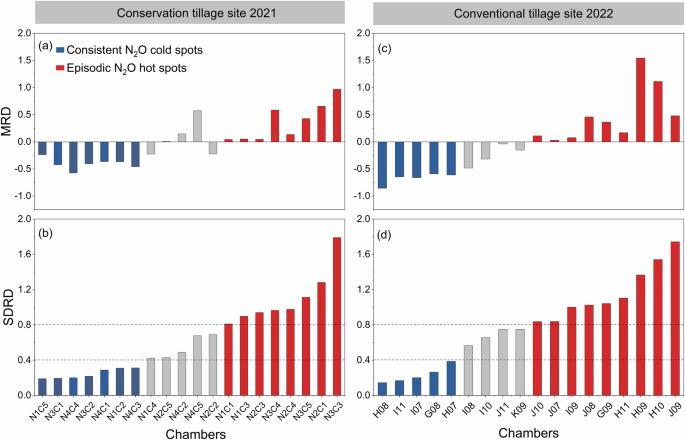A conceptual model explaining spatial variation in soil nitrous oxide emissions in agricultural fields
IF 8.1
1区 地球科学
Q1 ENVIRONMENTAL SCIENCES
引用次数: 0
Abstract
Soil emissions of nitrous oxide contribute substantially to global warming from agriculture. Spatiotemporal variation in nitrous oxide emissions within agricultural fields leads to uncertainty in the benefits of climate-smart agricultural practices. Here, we present a conceptual model explaining spatial variation in temporal patterns of soil nitrous oxide emissions developed from high spatial resolution measurements of soil nitrous oxide emissions, gross nitrous oxide fluxes, and soil physicochemical properties in two maize fields in Illinois, USA. In sub-field locations with consistently low nitrous oxide emissions, soil nitrate and dissolved organic carbon constrained nitrous oxide production irrespective of changes in soil moisture. In sub-field locations where high emissions occurred episodically, soil nitrate and dissolved organic carbon availability were higher, and increases in soil moisture stimulated nitrous oxide production. These findings form the ‘cannon model’ which conceptualizes how sub-field scale variation in soil nitrate and dissolved organic carbon determines where increases in soil moisture can trigger high soil nitrous oxide emissions within agricultural fields. Only in areas of agricultural fields where nitrate and dissolved organic carbon availability were high could soil moisture stimulate high nitrous oxide emissions, according to a conceptual model based on spatial measurements of emissions and soil properties.

解释农田土壤一氧化二氮排放量空间变化的概念模型
土壤中的一氧化二氮排放大大加剧了农业造成的全球变暖。农田内一氧化二氮排放的时空变化导致气候智能型农业措施效益的不确定性。在这里,我们介绍了一个解释土壤一氧化二氮排放时空变化模式的概念模型,该模型是通过对美国伊利诺伊州两块玉米田的土壤一氧化二氮排放、一氧化二氮总通量和土壤理化性质的高空间分辨率测量而建立的。在一氧化二氮排放量持续较低的子田块,无论土壤湿度如何变化,土壤硝酸盐和溶解有机碳都限制了一氧化二氮的产生。在偶尔出现高排放量的子田中,土壤硝酸盐和溶解有机碳的可用性较高,土壤水分的增加会刺激一氧化二氮的产生。这些发现形成了 "加农炮模型",它从概念上说明了土壤硝酸盐和溶解有机碳在亚田块尺度上的变化如何决定了土壤水分的增加会在哪些地方引发农田内土壤一氧化二氮的高排放。根据基于排放和土壤特性空间测量的概念模型,只有在硝酸盐和可溶解有机碳含量较高的农田区域,土壤水分才能刺激一氧化二氮的高排放。
本文章由计算机程序翻译,如有差异,请以英文原文为准。
求助全文
约1分钟内获得全文
求助全文
来源期刊

Communications Earth & Environment
Earth and Planetary Sciences-General Earth and Planetary Sciences
CiteScore
8.60
自引率
2.50%
发文量
269
审稿时长
26 weeks
期刊介绍:
Communications Earth & Environment is an open access journal from Nature Portfolio publishing high-quality research, reviews and commentary in all areas of the Earth, environmental and planetary sciences. Research papers published by the journal represent significant advances that bring new insight to a specialized area in Earth science, planetary science or environmental science.
Communications Earth & Environment has a 2-year impact factor of 7.9 (2022 Journal Citation Reports®). Articles published in the journal in 2022 were downloaded 1,412,858 times. Median time from submission to the first editorial decision is 8 days.
 求助内容:
求助内容: 应助结果提醒方式:
应助结果提醒方式:


